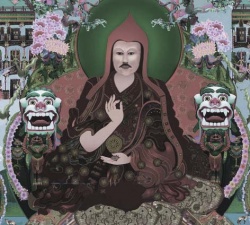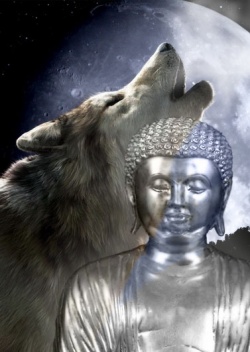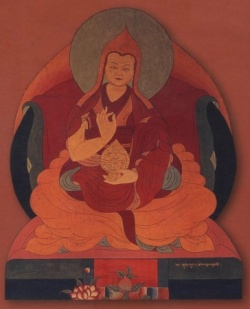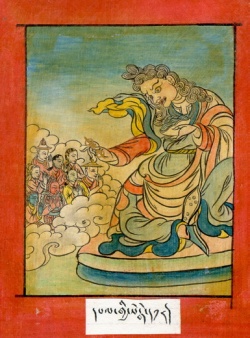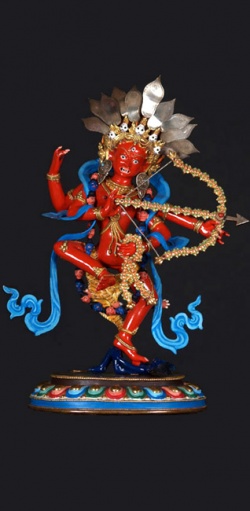Situ Penchen and the House of Sde dge
Rémi Chaix, École pratique des hautes études & Center for Himalayan Studies, CNRS
JIATS, no. 7 (August 2013), THL #T5747, pp. 17-48
Section 5 of 7 (pp. 27-32)
© 2013 by Rémi Chaix, IATS, and THL
Chaplain and trülku
During all these years of “trülku training,” Situ Penchen, coached by his uncle, acquired not only the skills and the legitimacy necessary for his role but also the awareness of his responsibility towards his masters and his order to preserve and transmit the Karma Kagyü heritage. From that time on it appears that the guidelines and the main goal of his life, based on his endless efforts and his competences, were to preserve, to transmit, and to enrich his order’s material and nonmaterial heritage. He seems therefore to have felt at that time that the House of Dergé’s control over his training and movements, due to his chaplain commitment, constituted a serious handicap in his Karma Kagyü trülku’s mission.
In the eighth month of the fire horse year (1726), by the time of Situ Penchen’s return, the House of Dergé’s interest in its young chaplain started to take shape. The potential chaplain in whom they had a vested interest now appeared attractive and promising. Firstly, he was considered one of the Karma Kagyü lineage holders, therefore respected by many lay and monastic communities in Kham. He had regained his Situ Trülku charisma, enhanced by the red hat prestige ceremony, which inspires attraction and devotion of the religious, laymen, and local chiefs. He also had already mastered the traditional sciences, especially astro-divination, medicine, and grammar. He had been introduced to the inner circles of power in Lhasa. Finally he had travelled throughout Tibet and Nepal, building a broad network of acquaintances.
So, despite the frustrating delay of Situ Penchen’s return, Tenpa Tsering, the queen, ministers, members of the House, and their main chaplain, Trashi Wangchuk, gave him a warm welcome with all respect due to his trülku and chaplain’s status. Situ Penchen bestowed on them longevity consecrations (tsewang gyatsa) and finally reached Penjor Gang. In the following days he presented a request to the king, along with a painting he had made of The Eight Great Mahasiddhas, for a place to establish Situ Trülku’s new see.24 The king granted Situ Penchen the site of Pelpung, where previously a Drigung Kagyü monastery stood, and work began in the second month of the fire sheep year (1727). Besides Tenpa Tsering’s numerous gifts, the grant of corvée labor (ulak) to raise the walls and the fact that the king had dispatched the minister Chökyong Lodrö as the project manager, Situ Penchen had to go in search [page 28] of supplementary financing. He went on several fundraising tours to collect, what he rather poetically called flower alms (metok sönyom), among secular and religious communities – mostly followers of the Karma Kagyü tradition. At each stop of his tour, he generally performed public blessings (tromwang, i.e. Avalokiteśvara (Chenrezik), Mañjuśrī [Jampeyang], Bhaiṣajyaguru [Sanggyé Menla], Maitreya Jampa, or Sarvavid’s Künrik permission to practice) and the red hat ceremony during the day, and private blessings and empowerments (gerwang, kyenselgyi wang, among others) in the evening. During these tours Situ Penchen also asserted his authority on the order’s monasteries, and he took charge of the young Karma Kagyü trülkus’ training after the passing away of the two leading masters, Khamtrül Künga Tendzin (1680-1728) and Zurmang Chetsang Sungrap Gyatso.
He frequently returned to follow the progress of work in Pelpung and to perform rituals for members of the House of Dergé. They mainly asked him for longevity consecrations. In 1729, for the first time, he was consulted by Tenpa Tsering about sending troops against Chakdü (Nyarong). He gave his answer after making a yangchar divination.25 During the eighth month of the earth bird year (1729), Situ Penchen invited all the members of the royal family and the political and religious authorities to the consecration rituals of Pelpung’ main temple and to celebrate, with great festivities, the Situ Trülku’s new see.26
Invited by Lijiang authorities, and with the approval of Tenpa Tsering, Situ Penchen went on a tour of the Karma Kagyü institutions in southern Kham in the iron dog year (1730). Even though he did not mention it clearly, Situ Penchen’s journey must also have been linked with his patron’s greatest project, the xylographic edition of the Kangyur. Indeed, a part of the textual sources for the Jangsatam edition, supervised by the Sixth Zhamarpa in the beginning of the seventeenth century, were still there.
In the first month of the iron pig year (1731) Situ Penchen received an order to come to Gönchen to contribute to the proofreading of the Kangyur. He complied immediately. After official celebrations he started to revise and correct several tantras, sometimes checking the translation from the Sanskrit versions. He stayed working at Gönchen for four months before he was able to resume his own activity in Pelpung and with the religious communities of Lhatok and northern Dergé. He spent the winter months, from the eleventh month of the iron pig year (1731) to the third month of the water mouse year (1732), in Gönchen to continue his proofreading work. He returned to his monastery only in the first day of the fourth month. There he received Tenpa Tsering’s order to compose the table of contents (karchak) of the Kangyur. This decision was not as obvious as it might appear today. The idea to take on this project had been raised by Sang gyé Püntsok (1649-1705), the former abbot of Ngor Ewam (1686-89), who later became Sanggyé Tenpa’s chaplain. Even though the block print edition project was officially launched in the seventh month of 1729, it was in 1718 that Tenpa Tsering had ordered the realization of woodblocks of several sūtras (different versions of the Sherchin (Prajñāpāramitā) and the Pelpoché Avataṃsaka) of the future Kangyur xylographic edition (parma).27 This work was under the supervision of his Ngorpa chaplain, Trashi Wangchuk. After the latter’s passing away, he was succeeded in his chaplain’s role by Trashi Lhündrup (1672-1739; abbot of Ngor Ewam, 1722-1725), who naturally became the supervisor of the project. So, one might have expected that he be entrusted with the redaction of the table of contents, a prestigious work. One may wonder what Tenpa Tsering’s intentions were by entrusting the task to Situ Penchen? No answer is provided by Situ Penchen, but it seems that the Ngorpa chaplain Trashi Lhündrup was very upset by this choice and decided, as he was still the supervisor, to edit only five of the eight chapters of the table of contents Situ Penchen had composed.28 Without specific evidence, we may try to explain the king’s choice, if reason has played a role in his decision, by a few facts that give legitimacy to Situ Penchen: he had received and given several times the reading transmission of the Kangyur; he mastered Sanskrit and Tibetan grammar; he was a high ranking trülku; and he belonged to an order among which several hierarchs were famous for their contribution to the edition of the Tibetan Buddhist Canon (just to mention a few: the Fifth Karmapa’s role in the Yongle edition and the Sixth Zhamarpa’s role in the Jangsatam edition of the Kangyur).
In mid-1732, the Eighth Situpa went to Amdo and met up with the Karmapa and the Zhamarpa on their way to Beijing (Pechin). Situ Penchen suggested that they should take him as their servant (zhapchi). They refused his offer, but entrusted him to protect the Karma Kagyü tradition and to make a xylographic edition of the Karma Kagyü liturgical texts (chöchö) in Pelpung.29 On his way back to northern Dergé, Situ Penchen acted as a peacemaker for the first time. He executed a ritual for warring parties to lay down their arms and engage in a peace agreement.
As the Karmapa and Zhamarpa passed away prematurely in China at the end of 1732, Situ Penchen became the order’s highest ranking hierarch and was therefore entrusted with the heavy responsibility of finding, enthroning, and bringing up their reincarnations. But he could not focus exclusively on his new role, as he had to honor his chaplain’s commitment and in particular to complete the corrections of the Kangyur edition. During the celebrations for the consecration of the [page 30] xylographic blocks in the second month of the wood tiger year (1734), Situ Penchen bestowed upon the royal family the consecration of Saṃvara, and the next day, a longevity consecration to six ministers and Vajravārāhī’s consecration to a large assembly headed by the king. Finally, on the twenty-first he bestowed the consecration of Gyelwa Gyatso and received a large number of presents.30 Maybe due to Situ Penchen’s new status, the requests and marks of respect from the House of Dergé noticeably increased, and we can also remark that he began at this point to give them tutelary deity’s empowerments, becoming in a way their tantric master.
In mid-1734 the king Tenpa Tsering let Situ Penchen go to Central Tibet to consecrate the Karmapa and Zhamarpa’s funerary stupas and to give his instructions to Tsurpu and Yangpachen’s authorities, as well as to train the young trülkus: the Seventh Pawo, the Fifth Treho Zhapdrung, the Sanggyé Nyenpa and others. Situ Penchen also took this opportunity to meet with Lhasa political and religious authorities, especially with Polhané (1689-1747). The sovereign of Tibet, who was carrying out his project to make the Tengyur xylographic edition, sought the services of Situ Penchen and offered him Sanskrit texts. Denigrating Dergé he argued that Central Tibet had so much more to offer to a brilliant scholar like him.31 Although Situ Penchen took the books, he declined the generous offer and remained faithful to his Dergé patrons.
As he was not very confident in the Seventh Gyeltsappa (1699-1765) and had to leave Central Tibet, he entrusted his master and friend Katok Tsewang Norbu (1698-1755) with the duty of watching over, and leading the research to find the Karmapa and Zhamarpa reincarnations, and of informing him of the progress.
Back in Dergé, Situ Penchen resumed his role as chaplain and spent a long time performing rituals for the members of the Dergé family, who were becoming more and more generous. At the beginning of the earth horse year (1738) Situ Penchen was summoned to come to the capital as Tenpa Tsering was critically ill. Despite numerous consecrations, blessings and rituals, the king passed away after three months of agony on the third day of the sixth month of the earth horse year. The funeral ceremonies were performed by the two main chaplains, Situ Penchen and Trashi Lhündrup until the eighth month. After the ceremonies the queen mother Tsewang Lhamo (d. 1744) honored Situpa with lavish gifts and became his disciple, staying for long periods of time in Pelpung to receive his teachings.
Without changing the terms and conditions of their relationship, the passing away of Tenpa Tsering, followed the next year by Trashi Lhündrup’s death, strengthened the status of Situpa as chaplain. Even though the Ngorpa chaplain was succeeded by Penden Chökyong (1702-1760) in 1740, the successors of [page 31] Tenpa Tsering, the other members of the House, and the local authorities of the kingdom were relying more and more on Situ Penchen’s numerous skills (ritual performer, divination, physician, editor, among others). This greatly reduced his availability for his personal duties.
During the following years Situ Penchen’s life resembles a race against time to meet with the demands of his Dergé patrons, those of the religious communities he was in charge of and those of the sponsors of the Kagyü order all over Kham as well as keeping up his lineage holder’s duties. Thanks to the help of Katok Tsewang Norbu in Central Tibet, he was able to supervise the recognition and education of the Thirteenth Karmapa, Düdül Dorjé (1733-1797). Concerning the Ninth Zhamarpa, Situ Penchen blamed the Seventh Gyeltsappa for his untimely passing away in 1740 and personally took charge of the recognition and education of the Tenth incarnation. After his fourth stay in Central Tibet (1745-1749), Situ Penchen brought Zhamar Mipam Chödrup Gyatso (1742-1792) with him to Dergé to ensure the training of his protégé. Following Tsewang Norbu’s wishes he even tried to install him on the throne of Katok in 1752, but this was thwarted by a coalition of monks from Golok and Rongpo, led by Drimé Zhingkyong (1724-1787?).32
The sicknesses and deaths of several members of the House of Dergé (Püntsok Tenpa [d. 1751] and Jemo Tsering [d. 1751], Sönam Gönpo, Chökyong Gönpo [d. 1767], and Trashi Wangmo [d. 1768]) took up much of his time and constantly forced him to change his plans. Despite this, he was allowed to travel again to Lijiang (1759) and to Central Tibet (1762-63) and he took on his lineage holder’s responsibility very seriously.
He spent the last years of his life transmitting his knowledge and experience to his disciples at his monastery and in the neighboring regions (mainly Lhatok and Nangchen). He even had the satisfaction of welcoming the Thirteenth Karmapa to Pelpung (1771-1772) and introducing him to the king of Dergé, Lodrö Gyatso (1723-1774), and the other members of the House of Dergé during the New Year festivities of the water dragon year (1772).33 As his health declined, in the eleventh month of the water snake year (1773) Situ Penchen asked the king to be allowed to retire from his chaplain’s duties and was granted permission.34 But Situ Penchen’s unwavering loyalty to the House of Dergé forced him to make a last sacrifice. Since 1771 war had been raging in Gyelrong, and Dergé’s armed forces were involved on the Manchu side. In 1773 Qing generals asked Situ Penchen repeatedly to come to the region, perhaps in order to help negotiate a truce or obtain the Gyelrong forces’ surrender. He refused several times with the support of the king, but in the twelfth month of the water snake year, the pressure [page 32] on his patron vis-à-vis Qing generals was so strong that he finally accepted to comply with the generals’ order.35 Although they had asked him to join them for the New Year, Situ Penchen, in poor health, proceeded slowly and made many stops on the way. His condition quickly deteriorated, and the king of Dergé dispatched his physician, but he arrived too late. Situ Chökyi Jungné passed away near Puyuk Chudo (in the Golok region) on the twenty-fourth day of the second month of the wood horse year (1774).
[24] Situ Chökyi Jungné, Té Situr Böpa Karma Tenpé Nyinjékyi Rangtsül Drangpor Jö Dridrel Shelgyi Melong, 140.
[25] Yangchar is a divination method according to the Svarodaya Tantra and considered by Tibetans as the Indian tradition of divination.
[26] Situ Chökyi Jungné, Té Situr Böpa Karma Tenpé Nyinjékyi Rangtsül Drangpor Jö Dridrel Shelgyi Melong, 147.
[27] Rémi Chaix, “Les aspects économiques de l’édition xylographique à l’imprimerie de Dergé (I),” in Edition, éditions: L’écrit au Tibet, évolution et devenir, ed. J.-L. Achard, A. Chayet et al., 85-113 (München: Indus Verlag, 2010).
[28] Situ Chökyi Jungné, Té Situr Böpa Karma Tenpé Nyinjékyi Rangtsül Drangpor Jö Dridrel Shelgyi Melong, 153.
[29] Situ Chökyi Jungné, Té Situr Böpa Karma Tenpé Nyinjékyi Rangtsül Drangpor Jö Dridrel Shelgyi Melong, 154.
[30] Situ Chökyi Jungné, Té Situr Böpa Karma Tenpé Nyinjékyi Rangtsül Drangpor Jö Dridrel Shelgyi Melong, 157.
[31] Situ Chökyi Jungné, Té Situr Böpa Karma Tenpé Nyinjékyi Rangtsül Drangpor Jö Dridrel Shelgyi Melong, 164.
[32] Situ Chökyi Jungné, Té Situr Böpa Karma Tenpé Nyinjékyi Rangtsül Drangpor Jö Dridrel Shelgyi Melong, 312.
[33] Situ Chökyi Jungné, Té Situr Böpa Karma Tenpé Nyinjékyi Rangtsül Drangpor Jö Dridrel Shelgyi Melong, 673.
[34] Situ Chökyi Jungné, Té Situr Böpa Karma Tenpé Nyinjékyi Rangtsül Drangpor Jö Dridrel Shelgyi Melong, 713.
[35] Situ Chökyi Jungné, Té Situr Böpa Karma Tenpé Nyinjékyi Rangtsül Drangpor Jö Dridrel Shelgyi Melong, 718.
Read more: http://www.thlib.org/collections/texts/jiats/#!jiats=/07/chaix/b5/#ixzz2sBOJnMTG
